Human Flower Project
There’s More to Life than Squirrels
Crocus and sweet box are blooming in Louisville. Allen Bush isn’t declaring victory but he’s out-of-doors, working with winter on its concession speech.
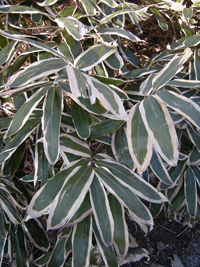 Sasa veitchii, in the author’s alley garden, March 2010
Sasa veitchii, in the author’s alley garden, March 2010
Photo: Allen Bush
By Allen Bush
Cold and gray is the lonesome price of a Kentucky winter. I pay little mind to the garden for three long months except to tap the kitchen window to shoo the squirrels away from the bird feeder. A sweet-scented, yellow-flowering Witch Hazel, Hamamelis mollis ‘Wisley Supreme’ ignores the winter forecast and blooms triumphantly for weeks in February and early March. I can also see bits of green that freckle the brown hued landscape of Hydrangeas seed heads and Panicum leaves.
My wife Rose contends I have it in for evergreens, but I don’t completely disown them. I can point to two pencil-thin boxwoods, Buxus ‘Graham Blandy,’ standing at attention in the back garden, and a young Yucca rostrata nearby, with leaves—like rigid-swords—that form a lovely hemisphere. Sasa veitchii, a medium-sized bamboo down by the back alley, has 10” lance-shaped leaves whose edges turn the palest brown after a hard autumn freeze. But none of these are the green, sculpted conifers that Rose wants so badly. The Taxus topiary hedge-in-progress, pruned to look like a big sofa, at the end of the scree garden, is my concession to green blobs.
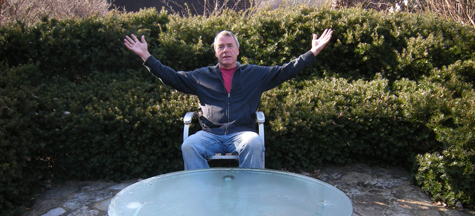
Allen Bush revels in a warm(er) March day, kicking back by the Taxus sofa.
Photo (detail): Rose Cooper
Carex plantaginea, fine sedge and a good emerald-green colored groundcover, looks as good as it did in September. We should have more of them, I argue. And more Rhodeas, Arums, Cyclamen hederifolium, or some patches of Carex morrowi ‘Silk Tassel‘ —something subtle and herbaceous.
I’m happy with my winter break and pity the poor souls who have to weed all year long. I realize someplace warm and sunny might be a good tonic for early February (I’d volunteer to weed!), but I’d prefer the usual Kentucky winter, just shortened by a few weeks. Sometime later on in February, with winter not quite vanished, I’ll be startled by a day with clear skies, and I suddenly realize there’s more to think about than squirrels. A few catalog plants, coveted all winter, will be ordered and my scuffle hoe sharpened.
 Crocus chysanthus ‘Blue Bird’: an early bird, too
Crocus chysanthus ‘Blue Bird’: an early bird, too
Photo: Allen Bush
The foliage on one of my favorite Coral Bells, the one with a doozy of a name, Heuchera villosa var. macrorrhizza, stays fresh-looking in spite of snow and cold. Its first new leaves are chartreuse and brighten-up shady spots. A nursery person years ago, recognizing the obvious merits of a plant saddled with a botanical variety name long on Rs and Zs, cleverly anointed a new name: ‘Autumn Bride’ – – with “gorgeous white blossoms in September.” The northern Alabama endemic was henceforth stripped of its Latin birthright and became popular overnight. (The cultivar name ‘Autumn Bride’ has no botanic legitimacy, but those of us in the horticultural pro ranks turn an occasional blind eye for commercial opportunity. There’s precious time for lessons in binomial nomenclature when garden centers find themselves at the mercy of a few sunny spring weekends to try and turn an annual profit.)
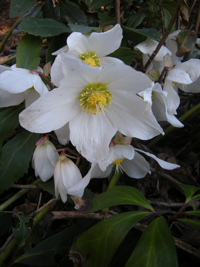 The Christmas Rose (Helleborus niger)
The Christmas Rose (Helleborus niger)
Photo: Allen Bush
The usual suspects were blooming as the snow melted. Snowdrops couldn’t wait any longer. And the long delayed pure white flowers of Christmas Rose Helleborus niger, huffing and puffing for weeks, looking for a short string of warm days, coincided, at the beginning of the Lenten season on February 21st, with the first hint of bloom on multi-colored selections among Lenten Rose Helleborus x hybridus. The Lenten Rose, misleadingly touted for its evergreen foliage, looks pretty beat-up and the old leaves need to be cut-back to let the fat February flower buds have a chance. What surprised me most, this year, was seeing hundreds of little Lenten Rose germinating seedlings coming-up under the snow. Though the temperature was still cold, the days must be lengthening just enough, and adequate light filtering through the snow, to trigger germination. Daughter Molly asked where she could get some Hellebores locally. I said, “Look no further. Take all the seedlings you want.”
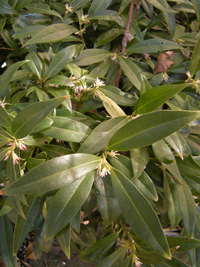 Less showy, more fragrant—Sweet box
Less showy, more fragrant—Sweet box
Photo: Allen Bush
The Sweet Box, Sarcococca hookeriana var. humilis, a name that sounds like a deadly staph infection – is March’s best kept secret. I love its low-growing, stoloniferous, short (12”) groundcovering habit, and have it planted in one-half dozen partially shady spots. Weeds find it impenetrable. Try to find the blooms? You might not notice them. They’re barely visible – not as obvious as the species crocus that are drawing the attention of honey bees – but you can’t miss the sweet fragrance.
Clumps of Phlox ‘Minnie Pearl’, scattered around the sunny borders, adjacent to the oval pond, come to life when I least expect them – and really need them. I love the fresh, slender lime green leaves that rumble out of the cold February ground—no taller, now in early March, than a short buzz-cut. The pure white blooms on elongated, mature 18” stems are the main feature, sometimes lost in the May shuffle. Minnie Pearl, the real McCoy, and star of the Grand Ol’ Opry, used to bellow: “How-w-w-DEE-E-E-E! I’m jes’ so proud to be here!”
Yes, indeed. A great big Howdy to spring!
Comments
How appropriate that a plantman’s spouse is named for a flower – Rose!
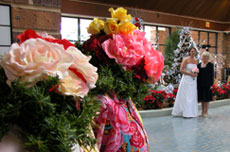

Alas, I have no Taxus sofas, nor even a Taxus loveseat or ottoman. Still waiting for those warm March days…we just got a foot+ of snow in the last week. I would greet spring, but it’s nowhere in sight.
Christine in Alaska